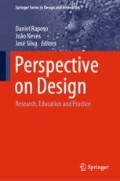Abstract
Towards the end of last millennium, cultural and technological development allowed humanity to severely alter the way we live, the objects of everyday life and how they were made and used. The advent of industrial production made it possible, for it contributed the rise of the Design professional, responsible for the ideation and project of products, filling the recently created gap between intent and machine production. For decades the seeds of post-industrial design have been identified by researchers, their bloom is now shown evident by growing number of people that try to avoid industrial goods. This has made the non-industrial market to become multimillionaire, attracting an increasing number of people to make products. Craftsmanship holds the roots of cultural variation and carries a long tradition of using sustainable materials and processes, values with increasing acknowledgement by the market. Recent events will be reviewed, which show that the present state of affairs combines both increasing market opportunities and communicational abilities for designers to develop products for non-industrial means of production. This study concludes that within this perspective, designers and craftspeople collaborations have an option to successfully develop sustainable products, while contributing for a more thoughtful and sustainable world.
Access this chapter
Tax calculation will be finalised at checkout
Purchases are for personal use only
References
Adamson G (2015) Essay by Glenn Adamson. In: Openshaw J (ed) Postdigital artisans—craftsmanship with a new aesthetics in fashion, art, design and architecture. Frame Publishers, Amsterdam, pp 286–288
Alpay Er H (2015) Padrões de desenvolvimento do design industrial no Terceiro Mundo: um modelo conceitual para países recém-industrualizados. In: Patrocínio G, Nunes JM (eds) Design & Desenvolvimento - 40 anos depois. Blucher, São Paulo, pp 29–54
Anderson C (2012) Makers—the new industrial revolution. The Crown Publishing Group, New York
Azua M (2017) Modelos colaborativos Artesanía/Diseño. In: 7o encontro bid enseñanza y diseño: territorio_diseño. Madrid. Retrieved from https://youtu.be/pq1N_g-6E7Y?list=PLjddHonD1FrjvyBAwMurJY9v7ya6Ki1v9
Bonsiepe G (1973) Development through design. Viena
Bonsiepe G (2011) Design, cultura e sociedade. Blucher, São Paulo
Borges A (2011) Design + Artesanato - o caminho brasileiro. Editora Terceiro Nome, São Paulo
Branco V (2014) Design e investigação em design: alguma reflexões. In: Vilar ET (ed) Design et al. - dez perspectivas contemporâneas. D. Quixotepp, Lisboa, pp 169–185
Bürdek B (2005) Design: the history, theory and practice of product design. Birkhäuser, Basel
Burke J (1985) The legacy of science. In: Burke J, Bergman J, Asimov I (eds) The impact of science on society. NASA, Hampton, pp 3–30. Retrieved from https://history.nasa.gov/sp482.pdf
Casini P (1979) As filosofias da natureza. Editorial Presença, Lisboa
Cavalli A (2017) The master’s touch—essential elements of artisanal excellence. Marsilio Editori, Venice
Cross N (1981) The coming of post-industrial design. Des Stud 2(1):3–7
Dormer P (1995) Os significados de design moderno a caminho do séc. XXI. Centro Português de Design, Lisboa
Dorst K (2015) Frame innovation, create new thinking by design. The MIT Press, Cambridge
Frog (2013) Hartmut Esslinger—advice for designers. Retrieved 13 Dec 2017, from https://vimeo.com/59679411
Giedion S (1948) Mechanization takes command: a contribution to anonymous history. Oxford University Press, New York
Jakob D, Thomas NJ (2017) Firing up craft capital: the renaissance of craft and craft policy in the United Kingdom. Int J Cultural Policy 23(4):495–511. https://doi.org/10.1080/10286632.2015.1068765
KPMG (2016) Innovation through craft: Opportunities for growth—a report for the Crafts Council, (July). Retrieved from http://www.craftscouncil.org.uk/content/files/KPMG_CC_Innovation_Report.pdf
Luckman S (2015) Craft and the creative economy. Palgrave Macmillan, Basingstoke
Maciuika JV (2011) The Globalization of the Deutscher Werkbund—Design reform, industrial policy, and German foreign policy, 1907–1914. In: Adamson G, Riello G, Teasley S (eds) Global design history, 1st edn. Routledge, Abingdon, pp 98–106
Manzini E (2015) Design, when everybody designs. The MIT Press, Cambridge
Manzini E (2016) Design culture and dialogic design. Des Issues 32(1):52–59
Margolin V (2015) Design para o desenvolvimento: mapeamento do contexto. In: Patrocínio G, Nunes JM (eds) Design & Desenvolvimento - 40 anos depois. Blucher, São Paulo, pp 13–28
Moritsch HS (ed) (2018) Craft-based design—on practical knowldge and manual creativity. Niggli Verlag, Salenstein
NID (2015) History & background. Retrieved 29 April 2019, from http://www.nid.edu/institute/history-background.html
Nielsen (2015) The sustainability imperative—new insights in consumer expectations. Retrieved 20 Jan 2019, from https://www.nielsen.com/us/en/insights/reports/2015/the-sustainability-imperative.html
Norman DA, Verganti R (2014) Incremental and radical innovation: design research vs technology and meaning change. Design Issues 30(1):78–96. https://doi.org/10.1162/DESI_a_00250
Patrocínio G, Nunes JM (2015) 40 anos depois - entrevista com Gui Bonsiepe. In: Patrocínio G, Nunes JM (eds) Design & Desenvolvimento - 40 anos depois. Blucher, São Paulo, pp 75–82
Paulinyi A (1986) Revolution and technology. In: Porter R, Teich M (eds) Revolution in history. Cambridge University Press, Cambridge, pp 261–289
Pye D (1968) The nature and art of workmanship. Bloomsbury Academic, New York
Risatti H (2007) A theory of craft—function and aesthetic expression. The University of North Carolina Press, Chapel Hill
Robertson J (2008) The sane alternative—a choice of futures, 2nd edn. Retrieved from http://www.jamesrobertson.com/books.htm#sane
Rose D (2015) Essay by David Rose. In: Openshaw J (ed) Postdigital artisans—craftsmanship with a new aesthetics in fashion, art, design and architecture. Frame Publishers, Amsterdam, pp 60–63
Sennett R (2008) The craftsman. Penguin Books, London
UN (n.d.) Sustainable development goals. Retrieved 29 April 2019, from https://www.un.org/sustainabledevelopment/
WCCD (1996) Our creative diversity. Report of the World Commission on Culture and Development. Retrieved from https://unesdoc.unesco.org/ark:/48223/pf0000105586
WCED (1987) Report of the world commission on environment and development: our common future. New York. Retrieved from https://sustainabledevelopment.un.org/content/documents/5987our-common-future.pdf
Author information
Authors and Affiliations
Corresponding author
Editor information
Editors and Affiliations
Rights and permissions
Copyright information
© 2020 Springer Nature Switzerland AG
About this chapter
Cite this chapter
Colaço, P., Matos, D. (2020). Design(ers) Beyond Industrial. From Dissociation to Reassociation Through Craft. In: Raposo, D., Neves, J., Silva, J. (eds) Perspective on Design. Springer Series in Design and Innovation , vol 1. Springer, Cham. https://doi.org/10.1007/978-3-030-32415-5_27
Download citation
DOI: https://doi.org/10.1007/978-3-030-32415-5_27
Published:
Publisher Name: Springer, Cham
Print ISBN: 978-3-030-32414-8
Online ISBN: 978-3-030-32415-5
eBook Packages: EngineeringEngineering (R0)

